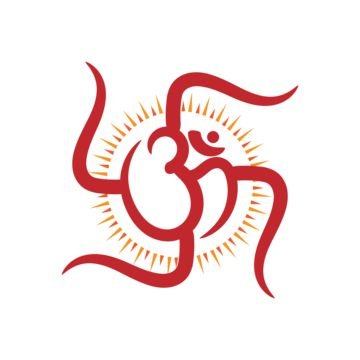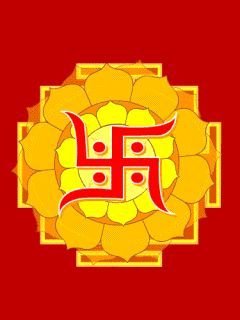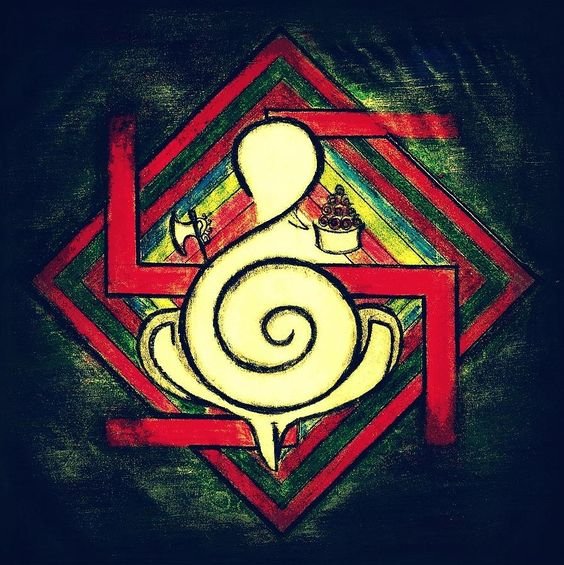Decoding Symbols of Hinduism: Swastika
- Ancient history Asian history European history Lifestyle
 Hoor Patel
Hoor Patel- May 2, 2024
- 0
- 103

The symbol of Swastika, is yet another, in fact the most auspicious and important of symbols in Hinduism. Similar to its usage as that of the symbol Om, Swastika—a shape of two crosses—is drawn outside of Hindu homes, on vehicles, used elaborately during the weddings and carved on the walls and architectural designs of Hindu temples. It is believed in the religion, that Swastika has the same reverberation of the primal sound as that of the symbol Om, when the universe was first created. A Sanskrit word, svastika, means well-being, and is widely associated with everything auspicious.

The ancient symbol of Swastika is incorporated within religions such as Jainism and Buddhism, but predominantly seen and used in Hinduism. In Hinduism, it is believed that the right facing symbol is Swastika, representing the Sun god Surya, implying notions of prosperity and good luck. This imbedded belief of prosperity and good luck, is why, many practitioners of the religion, smear and draw the symbol before starting anything new, such as the beginning of the yearly account book. Whereas, the left facing symbol is called sauvastika, representing the changing of the day into night or the goddess Kali and the tantric aspects of her. Kali, in Hinduism is associated with time and change alongside destruction and death. In this manner, the deeper meaning behind the Swastika symbol lies in cyclical nature of life. Surya as the right symbol represents the creation, rejuvenation and preservation of life and, Kali as the left symbol represents the inevitable end. As a whole, in its entirety, Swastika symbolizes the ever continuing cycle of creation, preservation, and destruction.

Furthermore, in Hinduism the four hands or limbs of the Swastika symbol is believed to be a representation of everything that is in fours. For example, the four hands curved at the right angle of the symbol are believed to be a representation of the four Vedas: the Rig Veda, Yajur Veda, Sama Veda and the Atharva. These four Vedas or the Veda in general form the fundamental basis of the teachings of Hinduism. Secondly, the limbs also represent the four stages of life: Brahmacharya, Grihastha, Vanaprastha, Sannyasa. According to Hindu belief, a human is born to complete the cycle of the four stages of life. A young person is said to be in the brahmacharya stage, that is a student, from there the person transitions into the stage of grihastha, meaning a householder where they are involved with family and home life; in the later stages the person enters into vanasprastha, or the age of retirement, then entering into the state of renunciation or rejection of material world that is the sannyasa. Swastika also inculcates representations of the four goals of life: Dharma, Artha, Kama, Moksh; the four seasons and the four directions. It is believed that the planets, a significant aspect of the religion involving astrology, find its representations in the symbol of Swastik, affirming to the symbols meaning of well-being, prosperity, change, time and destruction.

Swastika is generally associated with the elephant God, said to be the remover of obstacles and the embodiment of prosperity and good fortune. Similarly, the Puranas say that there in total a number of sixteen special signs on the feet of God Narayan or Vishnu, the preserver of the universe, and one of the sixteen signs is the Swastika symbol. This makes the Swastika all the more auspicious and of importance, as it can be interpreted as a symbol of divinity associated with the divine Gods.
Apart from Hinduism, Swastika also appears in Jainism. It was collectively accepted by all Jain sects in 1975 as one of the symbols of Jainism. Swastika symbolizes the four states of existence and the spiritual teachers and saviours. On the other hand, Buddhist too hold the symbol as an important part of their religion. Often linked to the auspicious footsteps of Buddha, the symbol is drawn and painted on the Buddhist temple. In East Asia, Swastika is used to represent Buddhism and the Buddhist temples. This ancient symbol is also found in the Chinese characters and hence is found in many Buddhist art. In Norse mythology, it is believed that Swastika represents Thor’s hammer, the God of thunder and lightening.

The symbol of Swastika has been a recurring theme in the artefacts, coins, and remnants of buildings excavated over the years across the globe. In ancient Greek, the symbol has been used as a decorating shape inscribed in the pots and vases. The use of the symbol has also been unearthed in what is left of the remains of the ancient city of Troy, founded around 3,000 BC. It is believed the Greek philosopher and mathematician Pythagoras used the Swastika symbol as a representation of heaven and earth. The presence of Swastika links the Trojans to the Aryan race.
Swastika was also used during the rebirth or revival of the European art and architecture that is the Renaissance. The symbol appeared in various forms of decorative elements in architectural designs and paintings. Renaissance marked the period of cultural rebirth and revival of classical learning and wisdom, which resulted in Renaissance artists drawing inspiration from classical age, including the ancient Greek and Roman designs. The Swastika was incorporated into ceilings and buildings. In paintings, the symbol was used in the background as part of decorative element, and was carved into furniture and other religious artefacts. The symbols presence in the art and architecture echoed the motif’s ancient association with themes of prosperity and well-being.

Similarly in Baroque art, in part a continuation of the Renaissance ideal, the Swastika occurs as a minor decorative detail in its art and architecture, unlike its heavy usage in the earlier periods. One notable example of the Swastika’s use in Baroque architecture is the Church of Santa Maria della Salute in Venice, Italy. The Church’s octagonal design features Swastika-like motif in its floor plan and interior decoration. These motifs are believed to represent the interconnectedness of the elements or the cycle of life. The earliest evidence of Swastika has been found in Mezine, Ukraine. The symbol is carved into a mammoth ivory figurine dating as early as about 10,000 BC.
For many years, the Swastika symbol has been synonymous to good fortune, prosperity and well-being. Used by civilizations across the world for centuries, the symbol has continued to flourish in its true essence of purity. However, soon in the early 20th century, this symbol of purity and goodness was paraded as a cause to establish one race as superior to the other, and became known all around the world for the cruelty it instigated. This major shift in what the symbol originally meant and to what it became associated with in the 20th century was due to the ideological meaning behind the findings of Schliemann’s site of ancient city of Troy in Turkey. The findings of the Swastika on various artefacts proved the possibility of the Trojans to have been Aryans, served as an evidence for the continuity of the race. As the German, romance and Sanskrit language had similar pronunciation; the Swastika became more and more intertwined with German nationalism, and Adolf Hitler’s ideology of Aryan supremacy and anti-Semitism leading to the creation of the Nazi party in early 1920s. With increasing wave of German nationalism, fuelled by Hitler’s influence, the Swastika was then adopted as the Nazi party symbol. The Swastika symbol in the modern period began to be seen as a representation of cruelty imposed by one group of people on another, and later on the symbol came to be recognized as a sentiment of anti-Semitism.

Under the Nazi rule, the Swastika was displayed on flags, uniforms, and other apparatuses. It became an emblem of Hitler’s regime and its extreme nationalism, militarism and anti-Semitism policies. After World War II, the Swastika was seen as another visual representation of fascism, genocide and hatred. In current world, especially in many European countries, laws prohibit display of the symbol because of its association with the Nazi ideologies and atrocities. However, laws in some countries permit the display of the symbol for religious purposes only.
The Swastika symbol, finding its origin in the ancient Indian language of Sanskrit, and seen as an emblem of goodness, well-being and prosperity in Hinduism, Jainism and Buddhism, and as a symbol of decoration in the lost city of Troy and among other ancient civilizations, to its incorporation in the most significant art movement of Italy that changed the trajectory of how art was viewed and made, to it being used as a sentiment of extreme nationalism; Swastika has remained a prevalent symbol for as long as humankind has existed.


